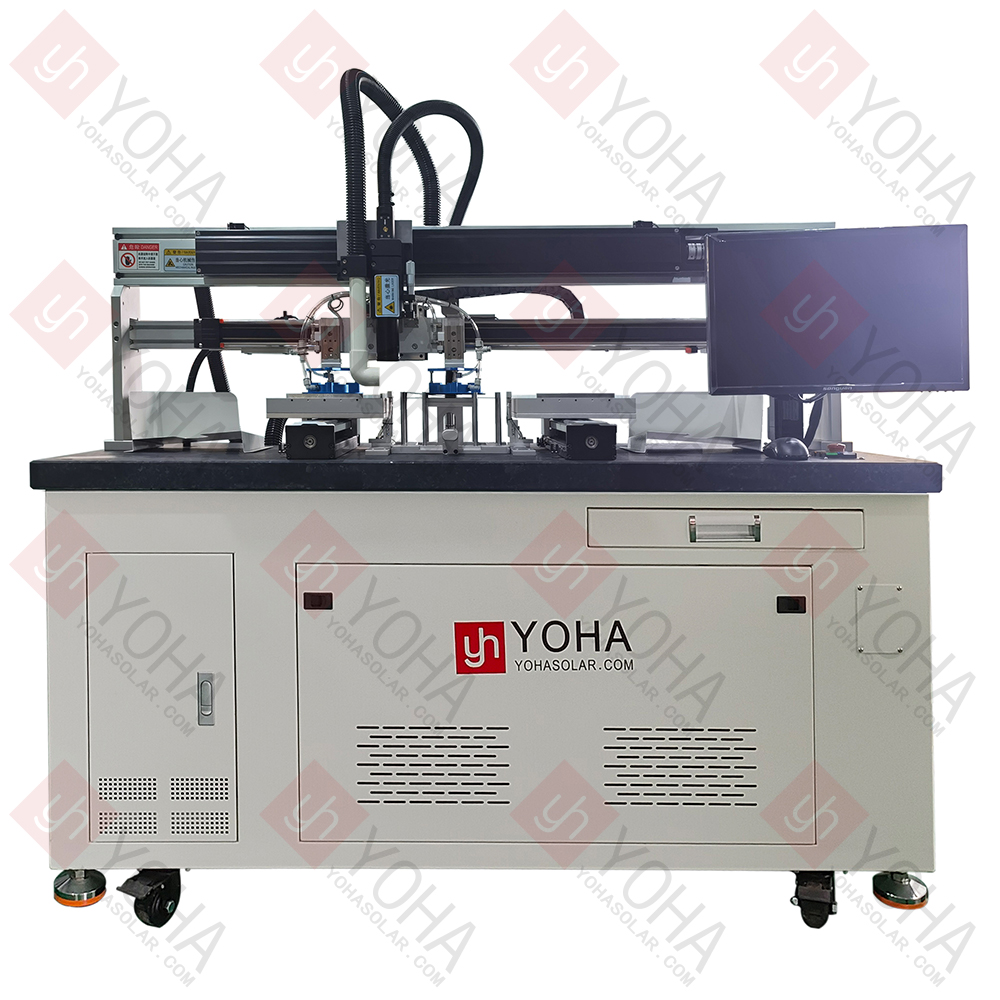Welcome to Wuhan Yoha Solar Technology Co., Ltd!
common problem
Site Map
Language:
 Chinese
Chinese
 English
English
Welcome to Wuhan Yoha Solar Technology Co., Ltd!
common problem
Site Map
Language:
 Chinese
Chinese
 English
English
The Automatic Solar Cell Fiber Laser Scribing Machine is a core photovoltaic production equipment. It utilizes a high-precision fiber laser source to perform fully automatic, ultra-precise, high-speed, and near-damage-free cutting (scribing) on silicon-based solar cells. This enables the separation of cells into smaller pieces or the processing of specific shapes.

High-Precision Fiber Laser: Employs a high-precision fiber laser to perform automated scribing/cutting operations on solar cells (primarily silicon-based), efficiently dividing whole cells into required sizes (e.g., half-cells).
Non-Contact Processing: Utilizes non-contact fiber laser processing, characterized by high precision, fast speed, minimal thermal damage (small Heat-Affected Zone - HAZ), and excellent edge chipping control. This significantly reduces cell damage and improves product yield rate.
Fine Processing Effect: Produces ultra-narrow, uniform kerfs with minimal chipping, maximizing the mechanical strength and electrical performance of the cells. This meets the requirements for subsequent high-precision processes like string soldering, making it a key process equipment for producing high-efficiency half-cell, shingled, and other advanced cell modules.
Enhanced Processing Efficiency: Significantly improves the processing efficiency and automation level of solar cell module production lines. It is a core production equipment in the photovoltaic manufacturing industry for boosting cell utilization and module power.
| Item | Parameter |
|---|---|
| Model | YHC-30 |
| Laser Type | 1064nm Fiber Laser |
| Beam Quality (M²) | 1.3 |
| Worktable Travel | 800×300mm |
| Max. Scribing Speed | 600mm/s |
| Scribing Accuracy | ≤0.02mm |
| Auto Positioning Accuracy | ≤±0.05mm |
| Cooling System | Air Cooling |
| Processing Range | 230×230mm |
| Compressed Air | 0.5~0.8MPa |
| Power Supply | 220V/50HZ |
| Equipment Dimensions | 2900×930×1740mm |
Core Link in PV Cell Manufacturing: This equipment is a key device on crystalline silicon solar cell (monocrystalline/polycrystalline) production lines. It is specifically designed for precisely cutting complete square or quasi-square silicon wafers (cell precursors) into the required smaller cell units (typically half-cells or smaller sizes). This is a fundamental step in manufacturing high-efficiency solar cell modules.
High-Efficiency Cell Processing (Half-Cut, Multi-Busbar Technology): Widely applied in producing mainstream half-cut cells and future third-cut, multi-cut cells. Precise laser scribing effectively reduces cell current, lowers resistive losses and hot spot risk, thereby significantly enhancing module power output and reliability.
Wafer Processing & Module Encapsulation Stages: Beyond cutting cell precursors during cell manufacturing, some equipment is also applied in:
Edge Treatment/Scribing after Initial Wafer Cutting: Performing precise cutting or edge trimming on wafers cut from the initial silicon ingot.
Cell Scribing Before Module Encapsulation: Scribing purchased standard whole cells before string soldering to meet the requirements of specific module designs (e.g., half-cut modules).
N-Type Cell Technology (TOPCon, HJT, IBC, etc.) & Thinner Wafer Applications: Particularly suitable for processing more efficient and thinner, more fragile N-type cells (e.g., TOPCon, HJT) as well as the industry's trend towards thinner wafers (e.g., <150μm). Its non-contact, cold processing characteristics with minimal HAZ maximize the reduction of cutting stress, ensuring high cutting yield rates and electrical performance for high-value cells.
Strict Laser Safety Protection:
This equipment uses a high-power fiber laser. The laser beam has extremely high energy; direct or reflected light can instantly burn skin or cause permanent eye damage.
Ensure safety interlock devices are intact and functional. Always wear laser safety glasses specified for the wavelength during operation and maintenance. Unauthorized personnel are strictly prohibited from entering the work area. Never open protective covers while the equipment is running.
Emphasize Dust Control & Explosion Prevention:
The laser scribing process generates large amounts of fine silicon dust. Silicon dust is combustible and poses an explosion risk if it reaches a certain concentration in the air and encounters an ignition source.
The equipment must be equipped with an efficient, sealed dust removal system (typically integrated or external), ensuring its continuous and stable operation. Regularly clean collection devices and ducts. Maintain good ventilation in the working environment. Operations that may generate sparks or open flames are strictly prohibited near the equipment.
Precise Control of Process Parameters:
Laser power, frequency, pulse width, scribing speed, defocus amount, and other parameters are crucial for scribing quality (edge chipping size, HAZ, cutting depth consistency).
When changing cell types (e.g., P-type to N-type, different thicknesses, different materials like TOPCon/HJT) or adjusting cutting dimensions (e.g., half-cut to third-cut), process parameters must be re-optimized and validated. Failure to do so will lead to reduced yield rates, increased breakage rates, and potential equipment damage.
Ensure Stable & Clean Operating Environment:
Temperature & Humidity Control: Core components like lasers and galvanometers are sensitive to temperature and humidity. Ensure ambient temperature (typically required at 23±2°C) and humidity (typically 40%-60%) remain stable within the equipment's specified range to prevent condensation, overheating, or performance drift.
Cleanliness: Dust, oil, and other contaminants adhering to optical lenses (focusing lens, protective lens, etc.) severely impact laser transmission efficiency and beam quality, causing poor scribing or even lens damage. Maintain cleanliness inside the equipment and the surrounding environment. Clean or replace optical lenses strictly according to the prescribed schedule.
Standardized Operation & Regular Maintenance:
Operation Standardization: Operators must undergo rigorous training to be familiar with the equipment structure, operation procedures, emergency stop protocols, and safety regulations. Loading, unloading, and replacing consumables (e.g., protective lenses) must follow procedures to avoid accidental contact with precision components.
Preventive Maintenance: Strictly execute the manufacturer's recommended periodic maintenance plan. This includes, but is not limited to: cleaning guide rails and lead screws, checking air/water line flow, calibrating optical systems (e.g., light path, CCD positioning), inspecting electrical connections, testing safety functions, and replacing wearing parts (protective lenses, dust filter elements, etc.). Maintain maintenance records to promptly identify and address potential issues.
TOP
18086473422
MESSAGE
